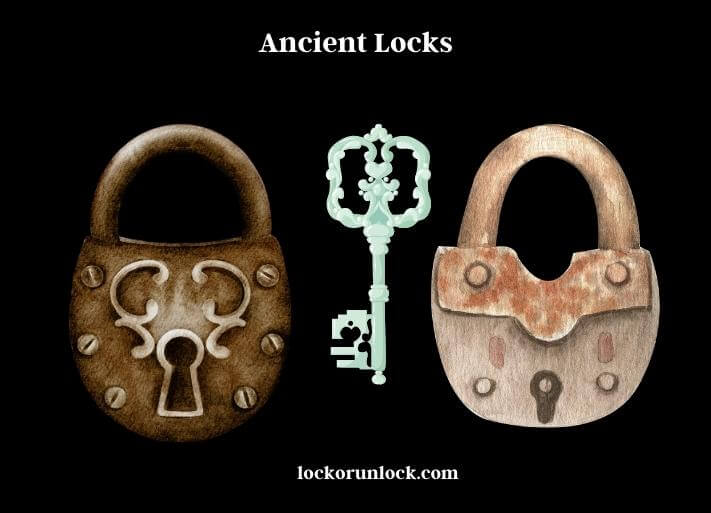Locks have been around for thousands of years, and they have played a crucial role in protecting people’s belongings and keeping them safe. From ancient wooden locks to modern combination locks, the design of locks has evolved over time. Locks come in various shapes and sizes, and they serve different purposes, whether it’s to keep valuables safe, secure buildings, or keep people out of restricted areas.
Locks have become an essential part of our lives, and we often take them for granted, but the stories behind the locks we use every day are fascinating and provide insight into the evolution of human technology.

The history of locks is as old as civilization itself. The first locks were made by the ancient Egyptians and were made of wood. The Roman Empire also had its own unique style of locks that were made from iron, bronze, or brass, and they were often decorated with intricate designs and symbols that held great significance. In China, locks were made from iron and bronze and were highly decorative, showcasing the craftsmen’s skill.
Locks have also played a significant role in popular culture. One of the most famous examples is the love locks of Paris. These locks can be found on bridges across the city, and couples often attach them to symbolize their love for each other. Another famous lock is the Traitor’s Gate Lock at the Tower of London. This lock was used to secure the entrance to the infamous Traitor’s Gate, which was used to bring prisoners into the Tower. Locks symbolism exploration extends beyond romantic and historical significance. In literature and film, locks are often used as a metaphor for secrets, barriers, and hidden truths. For example, in the Harry Potter series, the magical world is filled with enchanted locks that guard valuable items and keep dangerous creatures at bay. In “The Da Vinci Code,” locks and codes are essential to unraveling the mystery at the heart of the story. It is clear that locks have a rich and varied symbolism that has captured the imagination of creators and audiences alike.
History of locks
Locks have been used for thousands of years to secure valuable possessions and properties. The ancient Egyptians invented the first known lock around 4,000 years ago. This lock was made of wood and consisted of a bolt that slid into a hole in a door frame. The bolt was secured by a wooden key that had pegs of different lengths, which corresponded to slots in the bolt. When the key was inserted into the lock, the pegs would lift the bolt, allowing the door to be opened.
Over time, locks evolved and became more sophisticated. In ancient Rome, locks were made of iron and had intricate designs that were intended to prevent tampering. In medieval Europe, locks were often used on gates and castles to protect against invasions. These locks were often very large and heavy and required several people to operate.
In the 18th century, the first modern lock was invented by the Englishman Robert Barron. This lock used a lever mechanism that could be operated with a single key. Barron’s lock was much more secure than previous designs and quickly became popular throughout Europe.

In the 19th century, the first combination lock was invented. This type of lock used a series of numbers or letters to open the lock instead of a physical key. Combination locks are still used today and are often found on safes and lockers.
In the 20th century, locks became more advanced with the introduction of electronic and digital technology. Electronic locks use sensors and circuitry to control access, while digital locks use codes and algorithms to open and close. These types of locks are often used in high-security facilities such as banks and government buildings.
Today, locks are an essential part of our everyday lives and are used to secure everything from our homes and cars to our computers and smartphones. While the basic principles of locks have remained the same for thousands of years, new technology continues to revolutionize the way we secure our possessions and properties.
Ancient Locks
The earliest known locks were invented in ancient Egypt over 4,000 years ago. These locks were made of wood and consisted of a wooden post attached to a door, and a wooden bolt that slid into the post to lock it in place. The bolt was often carved with elaborate designs and symbols that held great significance to the ancient Egyptians.
In ancient Rome, locks were made from iron, bronze, or brass, and were often decorated with intricate designs and symbols. Roman locks typically had a keyhole at the top, and the key would be inserted into the lock, turning a series of internal pins that would release the bolt and allow the door to open.
In China, locks were made from iron and bronze and were highly decorative, showcasing the craftsmen’s skill. These locks were often shaped like animals or mythical creatures, and the key would be inserted into the lock and turned to release the bolt. The Chinese also developed the first combination locks, which used a series of rotating disks to release the bolt.

One of the most famous ancient locks is the ancient Roman lock from Pompeii. This lock was discovered in 79 AD during the excavation of the ancient Roman city of Pompeii, which was buried under volcanic ash from the eruption of Mount Vesuvius. The lock was made from bronze and featured a keyhole at the top, with a key inserted to turn a series of internal pins and release the bolt.
Another famous ancient lock is the Egyptian lock from the Tomb of Khafre. This lock was discovered in the tomb of the Pharaoh Khafre, who ruled over Egypt from 2520 to 2494 BC. The lock was made of wood and consisted of a post attached to the tomb’s door, and a wooden bolt that slid into the post to lock it in place.
Ancient locks played a crucial role in protecting valuable items and securing important buildings. They were the precursors to modern locks and provided the foundation for the development of more sophisticated locking mechanisms.
Medieval Locks
During the Middle Ages, the design of locks continued to evolve, becoming more complex and sophisticated. One of the most significant developments was the invention of the tumbler lock, which used a series of spring-loaded pins to prevent the bolt from sliding out of the lock.
Tumbler locks were first developed in the 14th century and were widely used throughout Europe. These locks consisted of a series of pins that would prevent the bolt from sliding out of the lock until the correct key was inserted and turned, causing the pins to align and release the bolt.
In the 16th century, the first combination locks were invented. These locks used a series of rotating disks with numbers or symbols on them to create a unique code that would release the bolt. Combination locks were often used on safes and strongboxes to protect valuable items.
During the Middle Ages, locks also became more decorative, with intricate designs and symbols carved into the lock’s body. One example of this is the medieval lock from the Louvre Museum in Paris, which dates back to the 15th century. This lock is made of iron and features a decorative floral design.
Another famous medieval lock is the Chubb detector lock, invented by Jeremiah Chubb in the early 19th century. This lock was considered unpickable, as it would trigger an alarm if anyone attempted to pick it up. The Chubb detector lock was widely used to secure important buildings, including banks and government buildings.
Medieval locks played a crucial role in securing valuable items and protecting important buildings during a time when theft and robbery were common occurrences. The development of tumbler locks and combination locks paved the way for modern locking mechanisms, and the decorative designs of medieval locks continue to be admired for their intricate beauty.
Modern Locks
The invention of modern locks can be traced back to the Industrial Revolution in the 18th and 19th centuries. As mass production became more common, locks became more affordable and accessible to the general public.
One of the most significant developments in modern locks was the invention of the cylinder lock by Linus Yale Jr. in 1861. The cylinder lock used a small cylinder that could be turned with a key, which would then cause a series of pins to align and release the bolt. The cylinder lock quickly became the standard locking mechanism for doors and is still widely used today.
In the early 20th century, the first electronic locks were developed. These locks used electronic signals to release the bolt, often in combination with a keypad or card reader. Electronic locks are now widely used in commercial and industrial settings, as well as in some residential applications.
In recent years, smart locks have become increasingly popular. Smart locks can be controlled remotely through a smartphone app or integrated with a home automation system, allowing for greater convenience and security. Smart locks often use a combination of electronic and mechanical locking mechanisms to provide maximum security.
Another recent development in modern locks is the use of biometric technology, such as fingerprint or facial recognition, to unlock doors. Biometric locks provide a high level of security and convenience, as the user does not need to carry a key or remember a code.
Modern locks continue to evolve and improve, with new technologies and materials constantly being developed. The importance of locks in keeping our homes, businesses, and valuables safe and secure remains as vital as ever.
Famous Locks in Popular Culture
Locks have played a significant role in popular culture, from books and movies to songs and artwork. Here are a few examples of famous locks that have captured the public’s imagination:
Master Lock
Master Lock is a well-known brand of padlock that has become a symbol of security and strength. One of the most popular and effective methods for cutting through a Master Lock is to use bolt cutters. The iconic image of a Master Lock being shot with a bullet and remaining intact has been used in advertisements and movies for decades.
The Vault in “Ocean’s Eleven”
In the 2001 movie “Ocean’s Eleven,” a team of thieves plans to rob a vault containing millions of dollars in cash and jewels. The vault is protected by a complex locking mechanism that requires a series of codes and electronic signals to unlock. The scene of the vault being opened is a memorable moment in the film.
The Heart-Shaped Lock in “Romeo and Juliet”
In William Shakespeare’s play “Romeo and Juliet,” the young lovers exchange vows of love and commitment using a heart-shaped lock and key. The lock represents their devotion to each other, and the key symbolizes their ability to unlock each other’s hearts.
The Golden Lock in “The Adventures of Tintin”
In the comic book “The Adventures of Tintin,” the young reporter and his dog, Snowy, embark on a quest to find a lost treasure. The treasure is hidden behind a golden lock that can only be opened by a key hidden within the pages of a book.
The Lock-in “The Tell-Tale Heart”
In Edgar Allan Poe’s short story “The Tell-Tale Heart,” the narrator becomes obsessed with the sound of a ticking lock in his room. The lock’s sound drives him to madness and ultimately leads to his downfall.
These famous locks have captured the public’s imagination and become symbols of security, love, and obsession. They remind us of the importance of locks in our daily lives and the power of symbolism in popular culture.
Unusual Locks
While locks are primarily used for security, there are some that have been designed with unusual or unexpected features. Here are a few examples of unusual locks that demonstrate the creativity and ingenuity of their inventors:
The Combination Locking Cane
Invented in the late 19th century, this cane featured a combination lock built into the handle. The lock was used to secure the cane when not in use, making it a practical accessory for those concerned about theft.
The Lock-Picking Pen
This unusual lock features a built-in pen that can be used to pick the lock. The pen is designed to fit into the keyhole and can be used to manipulate the lock’s pins and tumblers.
The Time Lock
This lock is designed to only open at specific times of the day or week. Time locks were often used in banks and other high-security locations to prevent theft during off-hours.
The Puzzle Lock
This lock requires the user to solve a puzzle or maze in order to unlock it. Puzzle locks are often used as brain teasers or toys, but they can also be used for security purposes.
The Eye Lock
This lock uses biometric technology to scan the user’s iris and grant access only to those whose eyes match the stored data. While not widely used, iris recognition technology is becoming more popular in high-security applications.
These unusual locks demonstrate the creativity and ingenuity of their inventors, as well as the wide range of uses for locks beyond basic security. Whether used for practical purposes or as a form of entertainment, locks continue to play an important role in our daily lives.
Conclusion
From ancient Egyptian locks made of wood and rope to modern biometric locks that use advanced technology, locks have evolved significantly over time. Their importance in providing security and peace of mind cannot be overstated.
Throughout history, locks have also taken on symbolic meaning, representing love, obsession, and protection. They have become iconic images in popular culture and have captured the public’s imagination.
Despite their evolution, locks continue to be important tools for securing our homes, businesses, and personal belongings. Whether it’s a simple padlock or a complex electronic system, the purpose of a lock remains the same: to keep our possessions safe.
